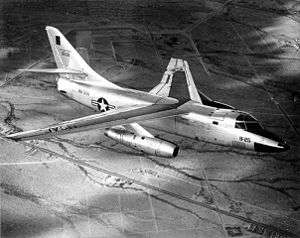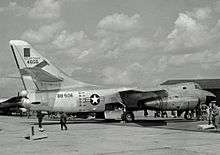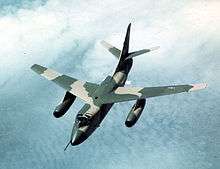Douglas B-66 Destroyer
| B-66 Destroyer | |
|---|---|
 | |
| A Douglas B-66B (53-506) in flight | |
| Role | Light bomber |
| National origin | United States |
| Manufacturer | Douglas Aircraft Company |
| First flight | 28 June 1954 |
| Introduction | 1956 |
| Retired | 1973 (USAF) |
| Primary user | United States Air Force |
| Number built | 294[1] |
| Unit cost |
US$2.55 million (RB-66B)[2] |
| Developed from | Douglas A-3 Skywarrior |
| Developed into | Northrop X-21 |
The Douglas B-66 Destroyer was a United States Air Force light bomber based on the U.S. Navy's A-3 Skywarrior carrier-based heavy attack aircraft. The B-66 was intended to replace the Douglas A-26 Invader, and an RB-66 photo-reconnaissance version was ordered simultaneously. The USAF B-66 retained the three-man crew from the US Navy A-3, but incorporated ejection seats that the US Navy variant lacked.
Design and development
At first, the United States Air Force intended the conversion to be an easy matter of removing the carrier-specific features, so no prototypes were ordered, just five pre-production RB-66A models (the reconnaissance mission being considered a high priority). The list of modifications grew, and before long, the supposedly easy conversion became what was substantially a new aircraft. Many of the changes were due to the USAF's requirement for low-level operations, while the Navy version had originally been designed and employed as a high-altitude nuclear strike bomber. Two major differences between the A-3 and the B-66 consisted in the types of jet engines used, and the emergency crew egress systems. The A-3 had two J57 turbojet engines, whereas the B-66 had two Allison J71s. The B-66 was equipped with ejection seats whereas the A-3 was not.
The first RB-66A pre-production aircraft flew in 1954, whereas the first production RB-66B aircraft flew in the beginning of 1955.
The basic B-66 design proved to be a versatile one, and was produced or modified into a variety of other versions, including the EB-66, RB-66, and the WB-66. Likewise, many variants of the A-3 Skywarrior were produced.
Operational history

Deliveries to the USAF began in 1956, with 145 of this model produced. RB-66s were used as the primary night photo-reconnaissance aircraft of the USAF during this time, many examples serving with tactical reconnaissance squadrons based in the United Kingdom and in West Germany. A total of 72 of the B-66B bomber version were built, 69 fewer than originally planned. A total of 13 B-66B aircraft later were modified into EB-66B electronic countermeasures aircraft for the cold war with Russia, and were stationed at RAF Chelveston with the 42 Tac Recon Sqdn who did the conversion in the early 1960s. They would rotate out of an alert pad in Spain during the time that the 42nd had them. These and the RB-66Cs that the 42nd had would eventually be sent to Vietnam. Unlike the U.S. Navy's A-3 Skywarrior, which performed some bombing missions, the Destroyer was not used as a bomber in Vietnam.
The RB-66C was a specialized electronic reconnaissance and Electronic Counter Measure (ECM) aircraft with an expanded crew of seven, including the additional electronics warfare experts. A total of 36 of these aircraft were built with the additional crew members housed in what was the camera/bomb bay of other variants. RB-66C aircraft had distinctive wingtip pods and were used in the vicinity of Cuba during the Cuban Missile Crisis and later over Vietnam. In 1966, these planes were renamed into EB-66C.
Unarmed EB-66B, EB-66C and EB-66E aircraft flew numerous missions during the Vietnam War. They not only helped to gather electronic intelligence about the North Vietnamese defenses, but also provided protection for the daily bombing missions of the F-105s by jamming North Vietnamese radar systems. Early on, B-66s flew oval "racetrack" patterns over North Vietnam, but after one of the aircraft was shot down by a MiG, the vulnerable B-66 flights were ordered back, just outside North Vietnam.
On 10 March 1964, a 19th TRS RB-66C flying on a photo-reconnaissance mission from the Toul-Rosières Air Base in France, was shot down over East Germany by a Soviet MiG-21 after it had crossed over the border due to a compass malfunction. The crew ejected and were taken prisoner briefly before being repatriated.
The final Douglas B-66 variant was the WB-66D weather reconnaissance aircraft, 36 of which were constructed.
The EB-66C/E was removed from USAF service by 1975 and most examples either scrapped in place or placed in storage for eventual scrapping.
Variants
- RB-66A
- (Douglas Model 1326) All-weather photo-reconnaissance variant, five built.
- RB-66B
- (Douglas Model 1329) Variant of the RB-66A with production J71-A-13 engines and higher gross weight, 149 built.
- B-66B
- (Douglas Model 1327A) Tactical bomber variant of the RB-66B, 72 built.
- NB-66B
- One B-66B used for testing and a RB-66B used for F-111 radar trials.
- RB-66C
- Electronic reconnaissance variant of the RB-66B, included an additional compartment for four equipment operators, 36 built.
- EB-66C
- Four RB-66Cs with uprated electronic counter measures equipment.
- WB-66D
- Electronic weather reconnaissance variant with the crew compartment modified for two observers, 36 built with two later modified to X-21A.
- EB-66E
- Specialized electronic reconnaissance conversion of the RB-66B.
Northrop X-21

The Northrop X-21 was a modified WB-66D with an experimental wing, designed to conduct laminar flow control studies. Laminar-flow control was thought to potentially reduce drag by as much as 25%. Control would be by removal of a small amount of the boundary-layer air by suction through porous materials, multiple narrow surface slots, or small perforations. Northrop began flight research in April 1963 at Edwards Air Force Base, but with all of the problems encountered, and money going into the war, the X-21 would be the last experiment involving this concept.[3]
Operators
- United States Air Force
- 1st Tactical Reconnaissance Squadron (RB-66)
- Spangdahlem Air Base, West Germany, 1957-59
- RAF Alconbury, UK 1959-66
- 9th Tactical Reconnaissance Squadron (RB/WB-66)
- Shaw AFB, South Carolina 1956-66
- 12th Tactical Reconnaissance Squadron (RB-66)
- Yokota Air Base, Japan 1956-60
- 19th Tactical Reconnaissance Squadron (EB/RB-66)
- RAF Sculthorpe, UK 1956-59
- Spangdahlem Air Base, West Germany 1959
- RAF Bruntingthorpe, UK 1959-62
- Toul-Rosieres Air Base, France 1962-65
- Chambley-Bossieres Air Base, France 1965-66
- Shaw AFB, South Carolina 1966-67
- 19th Tactical Electronic Warfare Squadron (EB/RB-66)
- Shaw AFB, South Carolina 1967-68
- Itazuke Air Base, Japan 1968-69
- Kadena Air Base, Japan 1969-70
- 30th Tactical Reconnaissance Squadron (RB-66C)
- Sembach Air Base, West Germany 1957-58
- 39th Tactical Electronic Warfare Squadron EB-66E/RB-66C
- Spangdahlem AB, Germany 1969-72
- 39th Tactical Electronic Warfare Training Squadron (EB/RB-66)
- Shaw AFB, South Carolina 1969-74
- 41st Tactical Reconnaissance Squadron (EB/RB-66)
- Shaw AFB, South Carolina 1956-59
- Takhli Air Base, Thailand 1965-67
- 41st Tactical Electronic Warfare Squadron (EB/RB-66)
- Takhli Air Base, Thailand 1967-69
- 42d Tactical Reconnaissance Squadron (B/EB/RB/WB-66)
- Spangdahlem Air Base, West Germany 1956-59
- RAF Chelveston, UK 1959-62
- Toul-Rosieres Air Base, France 1962-63
- Chambley-Bussieres Air Base, France 1963-66
- 42d Tactical Electronic Warfare Squadron (EB/RB-66)
- Takhli Air Base, Thailand 1968-70
- Korat Air Base, Thailand 1970-74
- 43d Tactical Reconnaissance Squadron (RB-66)
- Shaw AFB, South Carolina 1956-59
- 4411th Combat Crew Training Group (B/EB/RB/WB-66)
- Shaw AFB, South Carolina 1959-66
- 4416th Test Squadron (EB/RB-66)
- Shaw AFB, South Carolina 1963-70
- 4417th Combat Crew Training Squadron (EB/RB-66)
- Shaw AFB, South Carolina 1966-69
Aircraft on display

- RB-66B
- 53-0466 - Dyess Linear Air Park, Dyess AFB, Texas.[4]
- 53-0475 - National Museum of the United States Air Force at Wright-Patterson AFB, Ohio.[5]
- RB-66C
- 54-0465 - Shaw AFB, South Carolina.[6]
- JRB-66D
- 53-0412 - Chanute Aerospace Museum at the former Chanute AFB, Illinois.[7]
- WB-66D
- 55-0390 - USAF History and Traditions Museum at Lackland AFB, Texas.[8]
- 55-0392 - Museum of Aviation, Robins AFB, Georgia.[9]
- 55-0395 - Pima Air and Space Museum, adjacent to Davis-Monthan AFB in Tucson, Arizona.[10]
Specifications (B-66)
General characteristics
- Crew: 3 (Pilot, Navigator and EWO)
- Length: 75 ft 2 in (22.9 m)
- Wingspan: 72 ft 6 in (22.1 m)
- Height: 23 ft 7 in (7.2 m)
- Wing area: 780 ft² (72.5 m²)
- Empty weight: 42,540 lb (19,300 kg)
- Loaded weight: 57,800 lb (26,200 kg)
- Max. takeoff weight: 83,000 lb (38,000 kg)
- Powerplant: 2 × Allison J71-A-11 or -13 turbojets, 10,200 lbf (45 kN) each
Performance
- Maximum speed: 631 mph (548 kn, 1,020 km/h)
- Combat radius: 900 mi (780 nmi, 1,500 km)
- Ferry range: 2,470 mi (2,150 nmi, 3,970 km)
- Service ceiling: 39,400 ft (12,000 m)
- Rate of climb: 5,000 ft/min (25 m/s)
- Wing loading: 74.1 lb/ft² (361.4 kg/m²)
- Thrust/weight: 0.35
Armament
- Guns: 2 20 mm M24 cannons in radar-controlled/remotely operated tail turret
- Bombs: 15000 lb (6,803.9 kg)
Avionics
- APS-27 and K-5 radars
Notable appearances in media
The shooting down of an EB-66 over North Vietnam and the subsequent rescue of one of its crew became the subject for the book Bat*21 by William Charles Anderson, and later a film version (1988) starring Gene Hackman and Danny Glover.
See also
- Related development
- Aircraft of comparable role, configuration and era
- Related lists
References
Notes
- ↑ "Douglas B-66 Destroyer." National Museum of the United States Air Force. Retrieved: 5 August 2010.
- ↑ Knaack, Marcelle Size. Post-World War II Bombers, 1945-1973. Washington, DC: Office of Air Force History, 1988. ISBN 0-16-002260-6.
- ↑ "B-66 Information." B66.info. Retrieved: 5 August 2010.
- ↑ "B-66 Destroyer/53-0466." aerialvisuals.ca Retrieved: 4 June 2015.
- ↑ "Douglas RB-66B Destroyer." National Museum of the US Air Force. Retrieved: 24 August 2015.
- ↑ "B-66 Destroyer/54-0465." aerialvisuals.ca Retrieved: 4 June 2015.
- ↑ "B-66 Destroyer/53-0412" Chanute Aerospace Museum. Retrieved: 2 May 2013.
- ↑ "B-66 Destroyer/55-0390." aerialvisuals.ca Retrieved: 4 June 2015.
- ↑ "B-66 Destroyer/55-0392." Museum of Aviation. Retrieved: 21 May 2012.
- ↑ "B-66 Destroyer/55-0395." Pima Air & Space Museum. Retrieved: 4 June 2015.
Bibliography
- Baugher, Joe. "Douglas B-66 Destroyer." USAAC/USAAF/USAF Bomber Aircraft: Third Series of USAAC/USAAF/USAF Bombers, 2001. Retrieved: 27 July 2006.
- Donald, David and Jon Lake, eds. Encyclopedia of World Military Aircraft. London: AIRtime Publishing, 1996. ISBN 1-880588-24-2.
- "Douglas RB-66B 'Destroyer'." National Museum of the United States Air Force. Retrieved: 27 July 2006.
- Winchester, Jim, ed. "Douglas A-3 Skywarrior." Military Aircraft of the Cold War (The Aviation Factfile). London: Grange Books plc, 2006. ISBN 1-84013-929-3.
External links
| Wikimedia Commons has media related to Douglas B-66. |